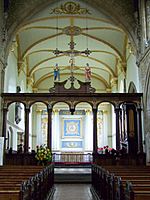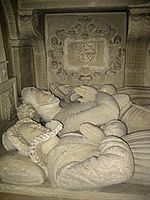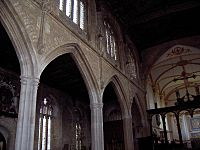St Mary's Church, Bruton facts for kids
Quick facts for kids St Mary's Church, Bruton |
|
|---|---|

St Mary's church from the south-west
|
|
| Lua error in Module:Location_map at line 420: attempt to index field 'wikibase' (a nil value). | |
| Location | Bruton, Somerset |
| Country | England |
| Denomination | Anglican |
| Architecture | |
| Functional status | Parish church |
| Style | Gothic, Rococo |
| Years built | 1350-1743 |
| Specifications | |
| Number of towers | 2 |
| Tower height | 102.5 feet (31.2 metres) |
| Bells | 6 |
| Tenor bell weight | 25cwt-3qrs-1lbs in D |
| Administration | |
| Parish | Bruton with Wyke and Redlynch |
| Benefice | Bruton, Brewham, Pitcombe and Shepton Montague |
| Deanery | Bruton and Cary |
| Archdeaconry | Wells |
| Diocese | Bath & Wells |
| Province | Canterbury |
The Church of St Mary in Bruton, Somerset, England, is a very old and beautiful church. Most of it was built in the 14th century. It is special because it has two towers, which is unusual for churches in Somerset. One expert, Simon Jenkins, said Bruton's main tower is "Somerset architecture at its most powerful." This church is so important that it is a Grade I listed building, meaning it's protected for its historical value.
Contents
History of the Church
Early Beginnings
The very first church on this spot was started by King Ine of Wessex way back in the 600s. Over time, it grew into a large religious house called an Augustinian priory. Later, it became Bruton Abbey. This happened just before the time when many monasteries in England were closed down by the king, known as the Dissolution of the Monasteries.
Even though the church was inside the abbey grounds, it always served as the main parish church for the people of Bruton. A parish church is where local people go for worship and community events. The church even had an office and possibly a schoolroom in its north tower.
Building the Church Towers
The oldest parts of the church you see today are the north aisle (a side section) and the north tower. These were built around 1350. The crypt (an underground room) beneath the chancel (the area around the altar) is also from this time. These three parts made up the original church.
The church was made much bigger in the 1400s. In 1445, work began on the much larger west tower. After that, a new south aisle and the main central nave (the main part of the church where people sit) were added. The roof and the clerestory (a row of windows high up) were started in 1506 and finished in 1523. The north aisle also got new window designs in the 1400s.
Later Changes and Features
The chancel was rebuilt in 1743 by Nathaniel Ireson. This part of the church has a different style called Rococo, which is very decorative. It has a shallow tunnel vault (a curved ceiling).
In 1875, a special screen called a rood screen was moved. It used to be under the main tower arch and held the organ. Now, it stands in the north tower. This screen was made in 1620 and has a style called Jacobean.
The Bruton branch of the Berkeley family has had a long connection with Bruton and this church. One famous member, William Berkeley, moved to America and became a colonial governor of Virginia. Because of this, St Mary's Church has links with Bruton Parish Church in Colonial Williamsburg in Williamsburg, Virginia, USA.
Church Architecture
The Two Towers
St Mary's Church is special because it has two towers. The bigger one, the west tower, was built between 1445 and 1446. It is part of a group of towers known as the "Mendip towers" and stands about 31.2 meters (102.5 feet) tall. This west tower is the main landmark of Bruton and can be seen from many places around the town.
The older north tower is placed unusually, right over the church porch (the entrance). It is simpler, with three levels, angled corner buttresses (supports), and a stair turret (a small tower with stairs).
West Tower Details
The west tower is built in the Perpendicular Gothic style, which means it has lots of decorative details. It has four levels. You can see a large 15th-century window with six sections, a clock face, and niches (small alcoves) with statues. The bell section has sets of three windows with two lights (sections) each, separated by pinnacled pilasters (flat columns). The top of the tower is crowned with four large pinnacles. The west tower was repaired in 1910, including new stonework and parapets (low walls) at the top.
Inside the Church
The central aisle of the nave was built in the late 1400s. It is a classic example of the late Perpendicular Gothic style. The way the west window is placed close to the tower arch is also typical of this style. The special "triple wave moulding" on the tower arch is said to be unique. The nave roof has a tie beam and king-post design, with alternating decorative and support beams.
The chancel is very different from the Gothic style of the nave. It was built in the Rococo or Late Baroque style. It has a plaster groin vault (a curved ceiling made by two vaults crossing), decorated with gold leaves. The reredos (a screen behind the altar) is carved with symbols of the Passion, the Sacraments, and the Trinity.
Church Bells
The bells of St Mary's Church are in the large west tower. The current set of six bells is the 9th heaviest set of six bells in the world used for change ringing (a special way of ringing bells in patterns).
These six bells have a long history. The oldest bell is the fourth one, made in 1528 by an unknown maker. The fifth bell was made in 1618 by John Wallis of Salisbury.
By 1752, there were six bells. Thomas Bilbie I made the first and third bells. The largest bell, called the tenor bell, was originally from 1528. It was recast (melted down and remade) in 1846 by Charles and George Mears.
In 1910, during tower repairs, all six bells were rehung by Llewellins & James of Bristol in a new metal frame. This frame still holds the bells today. In 1930, the tenor bell was recast again by John Taylor & Co of Loughborough. This is the bell that is still used today. It is 132 cm (52 inches) wide and weighs about 1309 kg (25 and three quarter long hundredweight). It rings the note D.
The entire set of bells was checked and repaired again in 1997 by Eayre & Smith. This included new parts for the lighter bells and repainting the frame. There is also a smaller sanctus bell, weighing about 75 kg (1 and a half hundredweight), made in 1749. It hangs above the six main ringing bells.
Notable Burials
Some important people buried at St Mary's Church include:
- Maurice Berkeley (died 1581)
- Charles Berkeley, 2nd Viscount Fitzhardinge
- John Berkeley, 5th Baron Berkeley of Stratton
- Maurice Berkeley (Somerset MP)
- Maurice Berkeley, 3rd Viscount Fitzhardinge
- William Berkeley, 4th Baron Berkeley of Stratton
The Church Parish
The Bruton and District benefice is a group of local churches that work together. The parish of Bruton with Wyke Champflower and Redlynch is part of this group. Other churches in this benefice include those in: Batcombe, Brewham, Lamyatt, Pitcombe, Shepton Montague, and Upton Noble.
Images for kids
-
Monument to Sir Maurice Berkeley and his two wives
See also
- List of Grade I listed buildings in South Somerset
- List of towers in Somerset
- List of ecclesiastical parishes in the Diocese of Bath and Wells





